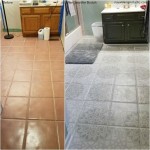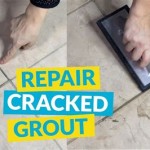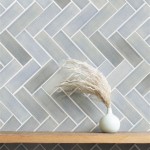How To Remove Bathroom Tile Without Breaking It
Removing bathroom tile can be a necessary step in a renovation project, whether updating the aesthetic or addressing underlying issues like water damage. While complete breakage and demolition are sometimes the goal, there are instances where preserving the tiles is desirable. This is particularly true for rare, custom, or expensive tiles that one might wish to reuse in a different location or salvage for future repairs. Removing bathroom tiles without breaking them requires patience, the right tools, and a methodical approach. This article outlines the process of carefully removing bathroom tiles, emphasizing techniques to minimize damage and maximize the chances of successful salvaging.
Before commencing any tile removal, proper preparation is crucial. This involves gathering the necessary tools and preparing the workspace. Having the correct tools readily available will significantly improve efficiency and reduce the likelihood of damaging the tiles. Workspace preparation helps protect both the surrounding surfaces and the individual performing the work.
The first step involves gathering the required tools. These include:
*A grout removal tool (grout saw, oscillating tool with grout removal attachment, or utility knife)
*A heat gun or hairdryer
*A putty knife or thin pry bar
*A hammer
*Safety glasses
*Gloves
*A dust mask or respirator
*A small bucket for collecting debris
*Cardboard or drop cloths
Once the tools are assembled, preparing the workspace is the next step. This includes laying down cardboard or drop cloths to protect the surrounding floor or surfaces from debris and accidental scratches. Ensure adequate ventilation by opening windows or using a fan. It is also crucial to wear safety glasses, gloves, and a dust mask or respirator to protect the eyes, hands, and lungs from grout dust and potential irritants.
Grout Removal: A Critical First Step
The grout surrounding the tiles is the primary adhesive holding them in place. Thorough grout removal is the most important step in minimizing the risk of tile breakage during removal. Insufficient grout removal forces one to exert more force when attempting to dislodge the tile, significantly increasing the likelihood of cracking or shattering it.
There are several tools suitable for grout removal. A manual grout saw is an inexpensive and effective option for smaller projects or delicate tiles. These saws feature a carbide-grit blade that gently grinds away the grout. An oscillating tool with a grout removal attachment provides a faster and more efficient method for larger areas. The oscillating action quickly removes grout without excessive force. A utility knife can be used for smaller areas or to clean up any remaining grout after using other tools. However, it requires more precision and care to avoid damaging the edges of the tiles.
Regardless of the tool chosen, the technique remains the same: carefully remove as much grout as possible from all sides of the tile. Work slowly and methodically, applying consistent pressure and avoiding excessive force. Pay particular attention to corners and edges, as these are often the most vulnerable areas. It is better to make multiple passes with light pressure than to attempt to remove all the grout in a single pass. This reduces the risk of chipping or cracking the tiles.
After the initial grout removal, use a vacuum cleaner or brush to remove loose grout dust. This will improve visibility and make it easier to identify any remaining grout that needs to be removed. Examine the grout lines carefully to ensure all grout has been removed, particularly in the corners and along the tile edges. Use a utility knife or grout saw to carefully clean up any remaining grout.
Loosening the Adhesive: Employing Heat and Patience
Once the grout has been thoroughly removed, the next step involves loosening the adhesive behind the tile. Modern tile adhesives are often incredibly strong, making this a challenging part of the process. Heat can soften many adhesives, making it easier to dislodge the tiles without excessive force. Employing heat requires caution to avoid overheating the tile or damaging the surrounding surfaces.
A heat gun or hairdryer can be used to apply heat to the tile and surrounding area. Set the heat gun to a low or medium setting and direct the heat evenly over the tile surface and edges. Avoid concentrating the heat in one spot for an extended period, as this can cause the tile to crack or the adhesive to melt excessively and create a mess. If using a hairdryer, use the highest heat setting and hold it close to the tile surface.
After heating the tile for a few minutes, test its adhesion using a putty knife or thin pry bar. Gently insert the putty knife or pry bar along the edges of the tile, attempting to create a small gap between the tile and the substrate. Apply gentle pressure and listen for any cracking or popping sounds. If the tile remains firmly attached, apply more heat and try again. The goal is to gradually loosen the adhesive without forcing the tile.
Patience is key during this stage. Avoid applying excessive force, as this will likely result in the tile breaking. Instead, work slowly and methodically, gradually loosening the adhesive around the entire tile. If the tile is particularly stubborn, try applying heat from the back side if possible. This may require accessing the area behind the wall or floor, which may not always be feasible. If access is possible, apply heat directly to the back of the tile to help soften the adhesive.
Pay attention to the type of adhesive used. Mastics, for instance, are more susceptible to heat softening compared to thin-set mortars. The duration and intensity of heat application should be adjusted accordingly. Always prioritize gradual loosening over forceful prying to minimize tile damage.
Tile Removal: Gentle Prying and Support
With the grout removed and the adhesive loosened, the final stage involves gently prying the tile away from the wall or floor. This requires a delicate touch and careful use of tools to avoid cracking or breaking the tile. Providing support to the tile as it is being removed can also help prevent damage.
Using a putty knife or thin pry bar, carefully insert the tool along the edges of the tile, working around the perimeter to gradually separate the tile from the substrate. Avoid using excessive force, as this will likely cause the tile to break. Instead, apply gentle pressure and work slowly, gradually increasing the gap between the tile and the substrate.
As the tile begins to loosen, use a second putty knife or pry bar to provide support on the opposite side. This will help distribute the pressure evenly and prevent the tile from cracking or breaking. Gently wiggle the tile back and forth to further loosen the adhesive. Be mindful of any resistance and adjust the pressure accordingly.
Once the tile is nearly detached, carefully remove it from the wall or floor. Clean off any remaining adhesive from the back of the tile using a putty knife or scraper. This will make it easier to reuse the tile later. Store the removed tiles in a safe place, such as a cardboard box lined with padding, to prevent them from being damaged.
If a tile breaks during removal, carefully remove the broken pieces and clean up any debris. Examine the surrounding tiles to ensure they have not been damaged. Repeat the process for the remaining tiles, taking extra care to avoid further breakage.
After all the tiles have been removed, clean the substrate thoroughly to remove any remaining adhesive or debris. This will prepare the surface for the installation of new tiles or other flooring materials. Careful preparation and cleaning are essential for a successful renovation project.
Removing bathroom tile without breaking it requires a combination of careful preparation, the right tools, and a patient approach. By following these steps, one can significantly increase the chances of successfully salvaging the tiles for reuse or future repairs. While complete success cannot be guaranteed, prioritizing gentle techniques and avoiding excessive force will minimize the risk of damage and maximize the value of the salvaged tiles.

How To Remove Floor And Wall Tiles Without Breaking Them

How To Remove Floor Tiles Without Breaking Them Ideas By Mr Right

How To Remove Tile Without Breaking

Easy Diy Guide On Removing Tiles From Walls Fantastic Handyman Au

How To Remove Tile Without Breaking

How To Remove Wall Tiles

How To Remove A Tile Backsplash Homeserve Usa

Remove Wall Tiles Without Damaging Plasterboard

The Best Way To Remove Old Shower Tile

How To Remove A Tile Floor
Related Posts








